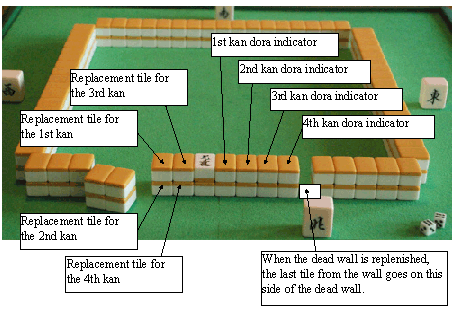A tile can only be claimed for a chow from the player on the left. Claiming the last discarded tile for a chow is done by first clearly calling “chow” or “chi”. Secondly the player reveals the matching tiles from the hand and thirdly discards a tile from the hand and claim the tile called for. For the third step the order of the two actions is not important: the player can take the claimed tile first and then discard, or the other way round.

Claiming the last discarded tile for a pung is done by first clearly calling “pung” or “pon”. Secondly the player reveals the matching tiles from the hand and thirdly discards a tile from the hand and claim the tile called for. For the third step the order of the two actions is not important: the player can take the claimed tile first and then discard, or the other way round.
Claiming the last discarded tile for a melded kong is done by clearly calling “kong” or “kan”, placing the tile face-up along with the three matching tiles from the hand. After revealing a new kan dora, the player takes a replacement tile from the dead wall and continues his turn as if he’d drawn a tile from the wall.
The dead wall always comprises 14 tiles, so after a kong the last tile of the wall becomes part of the dead wall.
A melded pung may be extended to a melded kong in a player’s turn after the player has taken a tile from the wall or a replacement tile, i.e. not in a turn where a tile was claimed for chow or pung. The player must call “kong” or “kan” clearly, place the fourth tile by the rotated tile of the pung and then reveal a kan dora and take a replacement tile. The tile used to extend the pung counts as a discard, and can be claimed for a win. The dead wall always comprises 14 tiles, so after a kong the last tile of the wall becomes part of the dead wall.
A concealed kong may be declared in a player’s turn after the player has taken a tile from the wall or a replacement tile, i.e. not in a turn where a tile was claimed for chow or pung. The player must call “kong” or “kan” clearly, reveal the four tiles of the kong, then turn the two middle tiles face-down, reveal a kan dora and take a replacement tile. The dead wall always comprises 14 tiles, so after a kong the last tile of the wall becomes part of the dead wall.
A player still has a concealed hand after declaring a concealed kong, if the player has no open sets.
A concealed kong cannot be robbed, except to win on Thirteen Orphans.
Note that four identical tiles only make up a kong, if a concealed kong is declared.



















